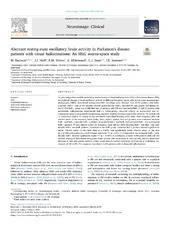| dc.contributor.author | Dauwan, Meenakshi | |
| dc.contributor.author | Hoff, Jorrit I | |
| dc.contributor.author | Vriens, Els M | |
| dc.contributor.author | Hillebrand, Arjan | |
| dc.contributor.author | Stam, Cornelis J | |
| dc.contributor.author | Sommer, Iris Else Clara | |
| dc.date.accessioned | 2020-04-28T05:44:38Z | |
| dc.date.available | 2020-04-28T05:44:38Z | |
| dc.date.issued | 2019 | |
| dc.Published | Dauwan M, Hoff, Vriens, Hillebrand, Stam CJ, Sommer IEC. Aberrant resting-state oscillatory brain activity in Parkinson's disease patients with visual hallucinations: An MEG source-space study. NeuroImage: Clinical. 2019;22:1-14 | eng |
| dc.identifier.issn | 2213-1582 | |
| dc.identifier.uri | https://hdl.handle.net/1956/22024 | |
| dc.description.abstract | To gain insight into possible underlying mechanism(s) of visual hallucinations (VH) in Parkinson's disease (PD), we explored changes in local oscillatory activity in different frequency bands with source-space magnetoencephalography (MEG). Eyes-closed resting-state MEG recordings were obtained from 20 PD patients with hallucinations (Hall+) and 20 PD patients without hallucinations (Hall-), matched for age, gender and disease severity. The Hall+ group was subdivided into 10 patients with VH only (unimodal Hall+) and 10 patients with multimodal hallucinations (multimodal Hall+). Subsequently, neuronal activity at source-level was reconstructed using an atlas-based beamforming approach resulting in source-space time series for 78 cortical and 12 subcortical regions of interest in the automated anatomical labeling (AAL) atlas. Peak frequency (PF) and relative power in six frequency bands (delta, theta, alpha1, alpha2, beta and gamma) were compared between Hall+ and Hall-, unimodal Hall+ and Hall-, multimodal Hall+ and Hall-, and unimodal Hall+ and multimodal Hall+ patients. PF and relative power per frequency band did not differ between Hall+ and Hall-, and multimodal Hall+ and Hall- patients. Compared to the Hall- group, unimodal Hall+ patients showed significantly higher relative power in the theta band (p = 0.005), and significantly lower relative power in the beta (p = 0.029) and gamma (p = 0.007) band, and lower PF (p = 0.011). Compared to the unimodal Hall+, multimodal Hall+ showed significantly higher PF (p = 0.007). In conclusion, a subset of PD patients with only VH showed slowing of MEG-based resting-state brain activity with an increase in theta activity, and a concomitant decrease in beta and gamma activity, which could indicate central cholinergic dysfunction as underlying mechanism of VH in PD. This signature was absent in PD patients with multimodal hallucinations. | en_US |
| dc.language.iso | eng | eng |
| dc.publisher | Elsevier | eng |
| dc.rights | Attribution CC BY-NC-ND | eng |
| dc.rights.uri | https://creativecommons.org/licenses/by-nc-nd/4.0/ | eng |
| dc.subject | MEG | eng |
| dc.subject | Visual hallucinations | eng |
| dc.subject | Multimodal hallucinations | eng |
| dc.subject | Cholinergic dysfunction | eng |
| dc.subject | Parkinson's disease | eng |
| dc.title | Aberrant resting-state oscillatory brain activity in Parkinson's disease patients with visual hallucinations: An MEG source-space study | eng |
| dc.type | Peer reviewed | |
| dc.type | Journal article | |
| dc.date.updated | 2020-02-14T10:18:38Z | |
| dc.description.version | publishedVersion | |
| dc.rights.holder | Copyright 2019 The Authors | eng |
| dc.identifier.doi | https://doi.org/10.1016/j.nicl.2019.101752 | |
| dc.identifier.cristin | 1721954 | |
| dc.source.journal | NeuroImage: Clinical | |

